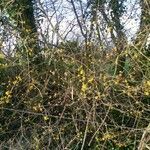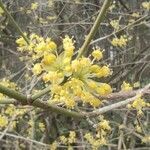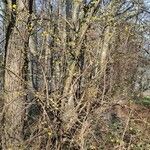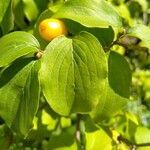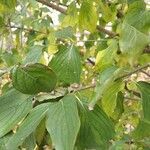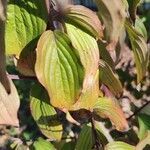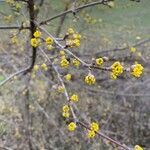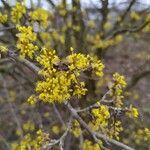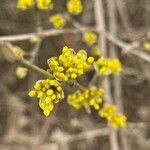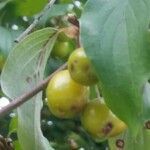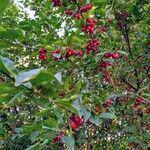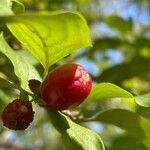Shrubs or small trees, to 5 m, flowering at 2 m. Stems solitary, branching profusely from lower trunk, bark of thin broad plates that shed sporadically, leaving a mottled gray-tan to red color; branches splotched with maroon, brown, or red, eventually splitting along longitudinal swellings; branchlets green, densely appressed-hairy; lenticels maroon swellings, often erupting with corky surface. Leaves: petiole 5–10 mm, base encircling twig; blade elliptic, 4–9 × 2–4 cm, base cuneate, apex acute or short acuminate, abaxial surface yellow-green, appressed-hairy, tufts of erect hairs in axils of secondary veins, adaxial surface dark green, sparsely appressed-hairy; secondary veins 4–5 per side, most usually arising from basal 1/2. Inflorescences 10–15-flowered; peduncle 5–10 mm; bracts tan or brown, ovate, 0.5–1 cm, apex obtuse with apiculate tip. Pedicels lax, apex flared. Flowers: hypanthium narrowly conic, appressed-hairy; sepals 0.1–0.5 mm; petals bright yellow, lanceolate, 3–4 mm. Drupes maturing from green to yellow, then red, ellipsoid, 10–15 × 5–7.5 mm; stone widely fusiform, 8–12 × 4–6 mm, with 2 lateral grooves on distal 2/3. 2n = 18
More
A very small tree. It has many branches. It grows 4.5-6 m tall. The leaves are opposite and pointed. The leaves are dark glossy green. They are 5-10 cm long and oval. There are 4-5 pairs of veins. Leaves are hairy on both surfaces. The buds are yellow. The flowers occur in small yellow clusters. There are 4 boat shaped flower bracts. The flowers develop on the leafless branches on short side shoots. Trees produce male flowers at first then female flowers later in their growth. The fruit are bright red and occur singly. They are oblong and 2 seeded. They are 15 mm long. They are edible. There are several named cultivated varieties.
The fruit are made into jellies and preserves. They are used in tarts. They can also be eaten raw. The fruit are also used for wine. The juice is added to perry and cider. The flowers are used to flavour spirits. The seeds are ground and used as a coffee substitute. The under-ripe fruit are pickled.
Plants can be grown from washed seeds. Seeds can take 18 months to germinate. Seeds stored for 3-4 months at about 4°C then soaked for a few hours in warm water germinate more easily. Plants can be grown from cuttings. Cuttings need to be grown for 2-3 years before planting out. Suckers can be used.
